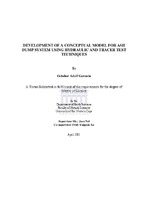| dc.description.abstract | Coal provides for 77% of South Africa’s primary energy needs and is therefore a major resource that supports the socio-economic needs of South African citizens. Power stations are the major consumers of coal in South Africa and produces electricity from burned coal. The burning of coal produces a large volume of ash that is disposed in the form of ash dump systems. The ash dump system is treated with high salinity process water from the power station for dust suppression. The process water contains salts due to evaporation processes from the recirculation of water in the cooling water system. Various studies to evaluate the sustainability of the ash dump system as a sustainable salt sink were therefore conducted. This study aimed to develop a conceptual model for the ash dump system by evaluating the movement of the process water trough the ash dump and the impacts it might have on the underlying weathered dolerite aquifer. This was achieved by evaluating the hydraulic and transport properties of the ash dump system. An initial site conceptual model was first established prior to the application of the hydraulic and transport methods. The initial conceptual model was based on the literature, previous reports and an initial site walk over. Known and tested hydraulic and transport methods were applied n bo.th field and laboratory scale for the saturated part of the ash dump system. The laboratory experiments comprised of column and core experiments. These methods assisted in parameter estimation of hydraulic and transport properties and also assisted in the planning of the field experiments. The field experiments were conducted in the form of slug tests, tracer dilution and natural gradient divergent tracer test experiments. The combined laboratory and field experiments provided statistically significant values that were then used as inputs into the conceptual model. Field experiments were also applied to a surrogate aquifer that represented the underlying shallow weathered dolerite aquifer of the ash dump system. The components of the updated conceptual model identified and investigated include the physical environment, the calculated hydraulic and transport properties.The ash dump can be conceptualized as a 20 to 30 meter high heap of consolidated clay size ash particles built on top of an underlying shallow weathered dolerite aquifer. The ash dup is directly connected to the underlying weathered dolerite aquifer. The saline water within the saturated zone has the ability to move through the ash dump system with hydraulic conductivities ranging between 10-1-10- 2 m/day, with flow velocities of 7-8m/day and effective porosities of 1%-2%. The hydraulic properties of the ash dump are, amongst others, controlled by the ash geology, contact time of the process water with the sh and show a significant reduction in hydraulic conductivity over time, before reaching a steady state. The transport properties are controlled by advection and spreading in available pathways. Results for the surrogate underlying fractured rock aquifer show flow velocities of 31m/day and an effective porosity of 1%.This suggests that the underlying weathered dolerite aquifer is vulnerable to process water contamination from the ash dump system. The study illustrates the importance of a site conceptual model before the application of investigative methods. Hence having a site conceptual model provides an excellent platform for hydraulic and transport estimation. The development of a site conceptual model enhanced the understanding of flow and transport movement of the processed water trough the ash dump, it also assisted as a beneficial tool to enhance ash dump management. | en_US |

